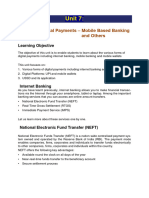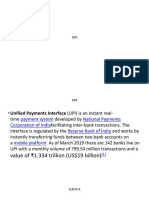My first document (1)
My first document (1)
Uploaded by
JAYDEEP CHOUHANCopyright:
Available Formats
My first document (1)
My first document (1)
Uploaded by
JAYDEEP CHOUHANCopyright
Available Formats
Share this document
Did you find this document useful?
Is this content inappropriate?
Copyright:
Available Formats
My first document (1)
My first document (1)
Uploaded by
JAYDEEP CHOUHANCopyright:
Available Formats
Unified Payments Interface (UPI):
UPI is a cutting-edge payment system that enables real-time transactions by
integrating multiple bank accounts into a single mobile app. This system,
created by the National Payments Corporation of India (NPCI) and overseen
by the Reserve Bank of India (RBI), combines various banking features,
effortless fund transfers, and merchant payments into one platform. UPI
facilitates transactions between banks, individuals, and businesses, allowing
for instant money transfers between bank accounts via mobile devices.
Key Features:
● 24/7 instant money transfers through mobile devices, 365 days a year
● Access to multiple bank accounts through a single mobile application
● One-click Two Factor Authentication, aligning with regulatory guidelines
while providing seamless payment
● Virtual address for transactions, enhancing security by eliminating the
need for sensitive information input
● Bill splitting functionality
● Solution for cash on delivery issues and ATM visits
● Unified merchant payment system and in-app payment options
● Various payment options including utility bills, over-the-counter, and QR
code-based transactions
● Trackable donations, collections, and disbursements
● Direct complaint lodging through mobile apps
UPI Participants:
● Payer PSP
● Payee PSP
● Payer's Bank
● Beneficiary Bank
● NPCI
● Bank account holders
● Merchants
Popular Digital Payment Apps:
❖ Google Pay
❖ Paytm
❖ PhonePe
❖ Internet Banking
UPI Transaction Types:
A. PUSH – Sending money using virtual address
i. User logs into UPI app
ii. Selects "Send money/Payment" option
iii. Enters payee's virtual ID, amount, and selects account for debit
iv. Reviews and confirms payment details
v. Enters UPI PIN
vi. Receives transaction status notification
B. PULL – Requesting money
i. User logs into bank's UPI app
ii. Chooses "Collect money" option
iii. Inputs payer's virtual ID, amount, and account for credit
iv. Reviews and confirms payment details
v. Payer receives money request notification
vi. Payer reviews request in their bank's UPI app
vii. Payer chooses to accept or decline
viii. If accepted, payer enters UPI PIN to authorize
ix. Payer receives transaction status notification
x. Payee receives notification and SMS for account credit
Unified Payments Interface is a real time interbank payment system that
allows
sending or requesting money.
Any UPI client app may be used and multiple bank
accounts may be linked to a single app.
Money can be send or requested with the
following methods:
● Virtual Payment Address (VPA) or UPI ID: Send or request money from/to
a
bank account mapped using VPA.
● Mobile number: Send or request money from/to the bank account mapped
using mobile number.
● Account number & IFSC: Send money to the bank account.
● Aadhaar: Send money to the bank account mapped using Aadhaar
number.
● OR code: Send money by QR code which has enclosed VPA, Account
number
and IFSC or mobile number. What makes UPI a secure platform?
This interface is based on the Two Factor Authentication with a seamless
single click
payment. This feature of UPI is aligned with the regulatory guidelines that
make it the
safest. Two Factor Authentication is quite similar to OTP.
Here, MPIN will be used instead of OTP. UPI Product
1. Financial Transactions: UPI supports the following financial transactions.
Pay Request: A Pay Request is a transaction where the initiating customer is
pushing funds to the intended beneficiary. Payment Addresses include
Mobile
Number, Mobile Money Identifier (MMID), Account Number, IFSC and
Virtual ID.
Collect Request: A Collect Request is a transaction where the customer is
pulling funds from the intended payee by using Virtual ID.
2. Non-Financial Transactions: UPI will support following types of
nonfinancial transactions:
❖ Mobile Banking Registration ❖ Generate One Time Password (OTP) ❖
Set/Change PIN ❖ Check Transaction Status ❖ Raise Dispute/Raise query
You might also like
- CEH - Module 2 - LabDocument4 pagesCEH - Module 2 - LabChang Carl100% (4)
- Research Proposal - Digital Payment System (BHIM UPI)Document13 pagesResearch Proposal - Digital Payment System (BHIM UPI)pooja joshi67% (3)
- Introduction To The Loxone SystemDocument43 pagesIntroduction To The Loxone Systemmbyaray75 Byaray100% (2)
- Xeusplayout Brochure PDFDocument2 pagesXeusplayout Brochure PDFzecter89No ratings yet
- UPI BriefDocument6 pagesUPI Brieftanjim.hasanNo ratings yet
- Project On UPIDocument17 pagesProject On UPIpallavimishra1109No ratings yet
- Upi ProjectDocument26 pagesUpi Projectradheshyamsharma9953No ratings yet
- HSBC Upi Leaflet 030417Document3 pagesHSBC Upi Leaflet 030417Mayur HariyaniNo ratings yet
- Unified Payment Interface (Upi)Document1 pageUnified Payment Interface (Upi)HIMANSHI GUPTANo ratings yet
- Understanding UPIDocument2 pagesUnderstanding UPIankit.codefluxNo ratings yet
- UpiDocument14 pagesUpiVegetaNo ratings yet
- Upi Faq Cbi V1Document3 pagesUpi Faq Cbi V1HemantNo ratings yet
- DEHUMANIZEDocument1 pageDEHUMANIZEtigerdanger246appsNo ratings yet
- Baroda Bhim Upi FAQDocument11 pagesBaroda Bhim Upi FAQabhinav MishraNo ratings yet
- Unified Payments InterfaceDocument29 pagesUnified Payments InterfaceBhaskar KothariNo ratings yet
- BHIMDocument29 pagesBHIMMohSin Kawoosa100% (1)
- Slidesgo Understanding Upi How Transactions Occur 20240422152053dTxZDocument14 pagesSlidesgo Understanding Upi How Transactions Occur 20240422152053dTxZSimple physicsNo ratings yet
- BANKING PSDA 2Document11 pagesBANKING PSDA 2Aditi GuptaNo ratings yet
- Unified Payments InterfaceDocument3 pagesUnified Payments Interfacevishwaharini56No ratings yet
- Unified Payment InterfaceDocument15 pagesUnified Payment InterfaceRavi Pareek100% (1)
- SynopsisDocument12 pagesSynopsisvikasmandapeNo ratings yet
- Unified Payments Interface - WikipediaDocument12 pagesUnified Payments Interface - WikipediaSankalp ZalaNo ratings yet
- Frequently Asked Question: Unified Payments InterfaceDocument5 pagesFrequently Asked Question: Unified Payments InterfaceumeshrrNo ratings yet
- Unit 7 Modes of Digital PaymentsDocument6 pagesUnit 7 Modes of Digital Paymentsshabdkul0309No ratings yet
- Product BookletDocument19 pagesProduct BookletAdityaNo ratings yet
- Digihelp Master File UpdatedDocument120 pagesDigihelp Master File UpdatedManis SinghNo ratings yet
- Olevel Ittnb b4 26may2020 ARTDocument4 pagesOlevel Ittnb b4 26may2020 ARTVedartha PathakNo ratings yet
- Unified Payment InterfaceDocument15 pagesUnified Payment InterfaceRavi PareekNo ratings yet
- Digital Payments: Step by Step Instructions For Various Modes of Payment: Upi, Wallets, Pos, and Sms Banking (Ussd)Document28 pagesDigital Payments: Step by Step Instructions For Various Modes of Payment: Upi, Wallets, Pos, and Sms Banking (Ussd)SpandanNandaNo ratings yet
- Unified Payments Interface: A Presentation OnDocument13 pagesUnified Payments Interface: A Presentation OnanupamNo ratings yet
- TECHNICAL ARTICLE BY RITESH PRAJAPATIDocument1 pageTECHNICAL ARTICLE BY RITESH PRAJAPATItigerdanger246appsNo ratings yet
- Digital Transaction 12Document24 pagesDigital Transaction 12sksalam2003No ratings yet
- Presentation: BHIM UPIDocument10 pagesPresentation: BHIM UPINo NameNo ratings yet
- Digital Payments: Step by Step Instructions For Various Modes of Payment: Upi, Wallets, Pos, and Sms Banking (Ussd)Document28 pagesDigital Payments: Step by Step Instructions For Various Modes of Payment: Upi, Wallets, Pos, and Sms Banking (Ussd)Mohit ShuklaNo ratings yet
- A. Automated Teller MachinesDocument3 pagesA. Automated Teller Machinesjayesh mirchandaniNo ratings yet
- Working and Architecture of UPIDocument4 pagesWorking and Architecture of UPISiddhant BoradeNo ratings yet
- Unified Payments Interface UPI Explained in PDFDocument5 pagesUnified Payments Interface UPI Explained in PDFnizam petaNo ratings yet
- What Is A Upi IntentDocument2 pagesWhat Is A Upi IntentlegalNo ratings yet
- Synd UPI TCDocument9 pagesSynd UPI TCneel bhangureNo ratings yet
- PCE II PresentationDocument20 pagesPCE II PresentationNitesh JadhavNo ratings yet
- Product Presentation UPIDocument61 pagesProduct Presentation UPIRedmi 10No ratings yet
- Exploring BHIM AppDocument7 pagesExploring BHIM AppSahajdeep BrarNo ratings yet
- New ProjectDocument28 pagesNew Projectakkota1562No ratings yet
- Digital Products Latest Changes SummaryDocument5 pagesDigital Products Latest Changes Summaryjyzdmk2p8gNo ratings yet
- Money Payment MethodsDocument20 pagesMoney Payment MethodsharshNo ratings yet
- Unified Payment Interfaces (Upi)Document37 pagesUnified Payment Interfaces (Upi)V.F.MUHAMMED ISMAIL THOUHEEDNo ratings yet
- BHIM User ManualDocument18 pagesBHIM User Manualshagunpundir9761No ratings yet
- Unified Payments Interface UPIDocument10 pagesUnified Payments Interface UPInehasajeevan09No ratings yet
- Digital Financial Tools and Applications: Objective of The ChapterDocument8 pagesDigital Financial Tools and Applications: Objective of The ChapterallindianursingtestNo ratings yet
- (Unified Payments Interface) : Made By:-Kartikeya Yogi Ritik Kumar YadavDocument23 pages(Unified Payments Interface) : Made By:-Kartikeya Yogi Ritik Kumar YadavRITIK YADAVNo ratings yet
- Padma Full PaperDocument8 pagesPadma Full Paperkayalvizhisrinivasan88No ratings yet
- Union Bank of India Credit Card Payment Through UpiDocument2 pagesUnion Bank of India Credit Card Payment Through Upisateesh008No ratings yet
- Financial Literacy 2023Document18 pagesFinancial Literacy 2023Kanika UpretiNo ratings yet
- Upi FaqDocument9 pagesUpi FaqSimran MunjhalNo ratings yet
- A Virtual Payment Address (VPA) Is An ID, Which A User Creates by Linking Their Bank Account To A Bank's Mobile ApplicationDocument3 pagesA Virtual Payment Address (VPA) Is An ID, Which A User Creates by Linking Their Bank Account To A Bank's Mobile ApplicationSUNNY SINGHNo ratings yet
- Upi 170710103904Document23 pagesUpi 170710103904Surya Teja VuttiNo ratings yet
- UPI - Product SolutionsDocument8 pagesUPI - Product SolutionsAmit SinghNo ratings yet
- Presentation of Digital PaymentsDocument28 pagesPresentation of Digital PaymentsAbdul BokhariNo ratings yet
- 14 9 16 Sanjay Saxena UPI PresntationDocument65 pages14 9 16 Sanjay Saxena UPI PresntationRamakrishna Pai BallambettuNo ratings yet
- Branchless BankingDocument10 pagesBranchless BankingJose HernandesNo ratings yet
- Cle 9Document44 pagesCle 9vishalsstudyingNo ratings yet
- Evaluation of Some Online Banks, E-Wallets and Visa/Master Card IssuersFrom EverandEvaluation of Some Online Banks, E-Wallets and Visa/Master Card IssuersNo ratings yet
- Evaluation of Some Online Payment Providers Services: Best Online Banks and Visa/Master Cards IssuersFrom EverandEvaluation of Some Online Payment Providers Services: Best Online Banks and Visa/Master Cards IssuersNo ratings yet
- Brown and Orange Organic Group Project Proposal PresentationDocument9 pagesBrown and Orange Organic Group Project Proposal PresentationJAYDEEP CHOUHANNo ratings yet
- TV and Film Treatment Deck Presentation in Black and White Grey Minimalist Style (1)Document9 pagesTV and Film Treatment Deck Presentation in Black and White Grey Minimalist Style (1)JAYDEEP CHOUHANNo ratings yet
- Ob Xerox MotivationDocument11 pagesOb Xerox MotivationJAYDEEP CHOUHANNo ratings yet
- Sample CP Report (1) (1) (1)Document77 pagesSample CP Report (1) (1) (1)JAYDEEP CHOUHANNo ratings yet
- SMDocument9 pagesSMJAYDEEP CHOUHANNo ratings yet
- My first documentDocument1 pageMy first documentJAYDEEP CHOUHANNo ratings yet
- Programming in LaTexDocument6 pagesProgramming in LaTexWang YanNo ratings yet
- Testing in The Lifecycle: Software Testing ISTQB / ISEB Foundation Exam PracticeDocument94 pagesTesting in The Lifecycle: Software Testing ISTQB / ISEB Foundation Exam PracticeChun ChunNo ratings yet
- ReWaRD User ManualDocument112 pagesReWaRD User Manualfrog15No ratings yet
- ThreatLocker Solutions Overview 2023 WebDocument12 pagesThreatLocker Solutions Overview 2023 WebErnesto MorenoNo ratings yet
- CP R80.40 EndpointSecurity AdminGuideDocument295 pagesCP R80.40 EndpointSecurity AdminGuideingwarrNo ratings yet
- (22223) - Model Answer-Q.6Document9 pages(22223) - Model Answer-Q.6rutujakjadjav2062No ratings yet
- SpeedStar and VariStar 2000 SWD Operations ManualDocument168 pagesSpeedStar and VariStar 2000 SWD Operations Manualahmed elsheikhNo ratings yet
- Dell Latitude D505: Intuitive Form Factors & DesignDocument2 pagesDell Latitude D505: Intuitive Form Factors & DesignAkshit BhagraNo ratings yet
- Inter La Ken Technology White PaperDocument16 pagesInter La Ken Technology White PapercalvinstanfieldNo ratings yet
- Major Project ReportDocument38 pagesMajor Project ReportDipak MarkamNo ratings yet
- SAP Fiori Apps Recommendations Report: How-To GuideDocument14 pagesSAP Fiori Apps Recommendations Report: How-To GuideYanira ParraNo ratings yet
- Amadeus Hotels Web ServicesDocument2 pagesAmadeus Hotels Web Servicesclyde gislard nkaya mambouNo ratings yet
- Bibtex and Annotated BibliographiesDocument2 pagesBibtex and Annotated BibliographiesSheetalNo ratings yet
- Configuring Two Wireless Routers With One SSID (Network Name) at Home For Free Roaming - Scott HanselmanDocument3 pagesConfiguring Two Wireless Routers With One SSID (Network Name) at Home For Free Roaming - Scott HanselmanCui Lan ZengNo ratings yet
- Citect OPC Server PDFDocument18 pagesCitect OPC Server PDFSai SatNo ratings yet
- TIA PORTAL Step7 Basic ManualDocument12 pagesTIA PORTAL Step7 Basic ManualBboyJeanko MarichalesNo ratings yet
- 02 Pillars of CyberSecurityDocument13 pages02 Pillars of CyberSecurityAnisa Nur HidayatiNo ratings yet
- ROV Control Sketches - Fourth Edition: ROV HS5803-14BA Depth Sensor HMC5883L Digital CompassDocument19 pagesROV Control Sketches - Fourth Edition: ROV HS5803-14BA Depth Sensor HMC5883L Digital CompassCarlos Daniel Rodrigo CNo ratings yet
- 2013Document365 pages2013praful_m_n100% (1)
- SimLab Composer BrochureDocument4 pagesSimLab Composer BrochureAlcigaireResearchNo ratings yet
- Release NotesDocument64 pagesRelease Notestest testNo ratings yet
- Business PlanDocument10 pagesBusiness PlanBhea Antonette Alcones Barbero100% (1)
- Essay: Artificial Intelligence (Chatgpt)Document6 pagesEssay: Artificial Intelligence (Chatgpt)Nabeel AhmedNo ratings yet
- Computer Quiz 3 Grade 3 Practice Sheet.Document4 pagesComputer Quiz 3 Grade 3 Practice Sheet.ezzeldin3khaterNo ratings yet
- Control System Mini Project-1Document7 pagesControl System Mini Project-1Binod MalikNo ratings yet
- Innovative Mini Project Smart FarmingDocument41 pagesInnovative Mini Project Smart Farmingakash GuptaNo ratings yet
- The Big Ideas of K-12 Computer Science Education: The Development of The Ideas Listed Below Is Explained in The PaperDocument18 pagesThe Big Ideas of K-12 Computer Science Education: The Development of The Ideas Listed Below Is Explained in The PaperSoukaynaNo ratings yet































































































